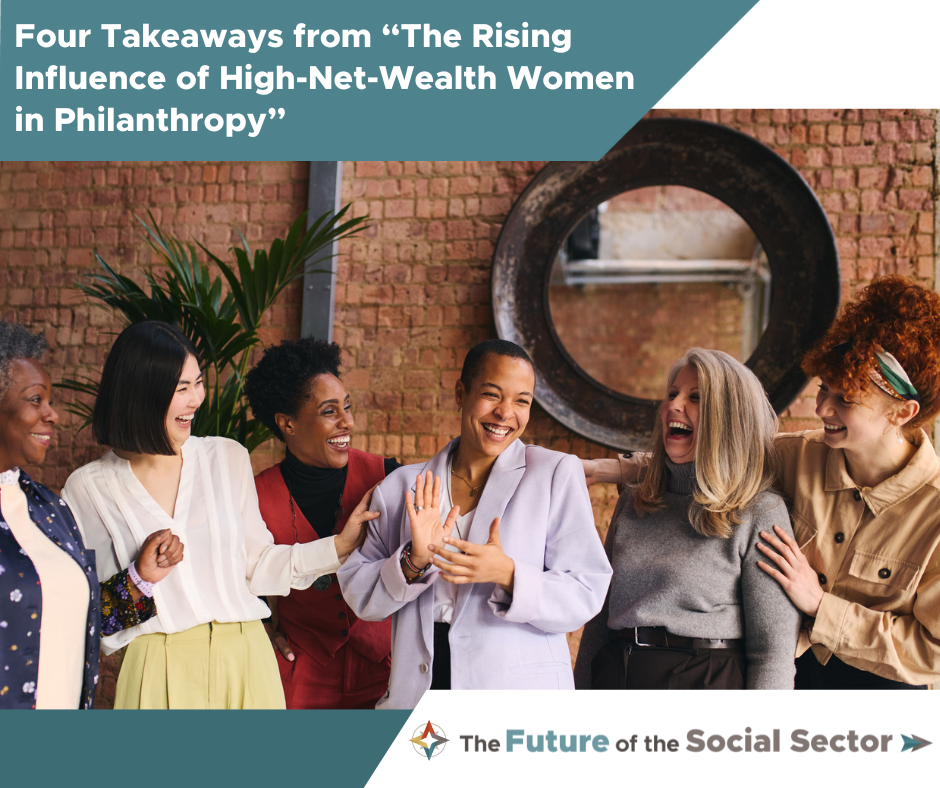Four Takeaways from “The Rising Influence of High-Net-Wealth Women in Philanthropy”

Women currently hold an average of 40 percent of global wealth. Additionally, experts predict that an unprecedented amount of assets—$30 trillion by 2030, by some estimates—will transfer into the hands of American women.
This wealth transfer provides an extraordinary opportunity for women to influence the philanthropic sector in ways that will have lasting implications for both those of us working in the field and society as a whole. And because women donors have historically taken radically different approaches to grantmaking than their male counterparts, we can expect to see significant—and constructive—changes over the coming years and decades.
As part of our Future of the Social Sector series, Arabella Advisors brought together a panel of experts to discuss how the role of high-net-wealth women in philanthropy has evolved and will continue to evolve as more wealth changes hands. The panel included Jeannie Infante Sager, the director of the Women’s Philanthropy Institute; Mona Sinha, board chair of Women Moving Millions and the global executive director of Equality Now; and Sarah Henry, the president of the Global Center for Gender Equality. Anne Green, a managing director at Arabella, moderated the panel.
In an inspiring conversation, panelists explored how wealth patterns have shifted over time, how women’s approaches to philanthropy often differ from those of men, and how the sector can better support high-net-wealth women. Couldn’t make the event? Check out the recording here, and let us know your thoughts about the following four primary takeaways:
- Takeaway 1: Women don’t do power over, they do power with. Philanthropy has historically been focused on giving strategies curated for an individual donor’s unique circumstances and priorities. This approach is not always appealing to women. Throughout time, women have approached philanthropic giving in a multitude of ways via a holistic approach that encompasses monetary gifts, volunteerism, business interests, and building family and community ties across their giving practices. Women often care deeply about what is transpiring within not only their own communities, but across the world, and ensure their giving takes this all into account. As Mona Sinha brilliantly stated, “It’s the generosity of women sharing their lived experiences and sharing the change they want to see in the world that is the greatest form of philanthropy.”
- Takeaway 2: Women approach philanthropy with a learning mindset. This requires more time and personal investment from both the funder and the grantee, but allows for innovation and experimentation. Women also work in collaboration with one another to be more inclusive and representative of the community as a whole. The current system is not set up for this and must be adapted to allow for more iterative and collaborative approaches.
- Takeaway 3: Women are challenging philanthropy’s status quo. The first philanthropists were white men, and their norms, vision, and legacy have persisted in the sector for many years. But the philanthropic sector is no longer driven exclusively by this dominant group. As more high-net-wealth women enter and take on more active roles in philanthropy, there is an enormous opportunity for them to disrupt the early norms and precedents—and we’re already seeing this take place. Compared to their male counterparts, women are more likely to give to philanthropic efforts and give higher amounts. Women are, anecdotally, more likely to believe that philanthropy is not just about cutting checks—it is about meeting people where they are and understanding the best way to engage to create real change.
- Takeaway 4: The future of philanthropy is female. With more women in philanthropy than ever before, the intergenerational transmission of wealth will transform the sector. Women are not only passing down monetary wealth, but also a wealth of knowledge and understanding about privilege. While Gen Z is doubling down on disrupting norms, it is important for women to not burden the next generation with solving the issues at hand—instead, women are teaching the next generation by modeling the work needed to enact change. Inheriting wealth can be daunting and the panelists encouraged women to take the time to challenge the thoughts and beliefs that have been passed from generation-to-generation, to ensure the giving is inclusive, equitable, and diversified.
The panelists also provided a list of four tips for women in the philanthropic sector:
- Identify your values. Defining what your values are and how you want to express those values is a great place to start determining your giving priorities.
- Philanthropy is a journey. Missing the mark on your philanthropic goals or taking a misstep is inevitable. Be patient and kind to yourself and focus on learning from any mistakes so you can carry those lessons forward with you.
- Double-down on disrupting the norms. The current space can often exclude women and people of color and the philanthropic sector needs to be intentional about inviting others to actively partake in philanthropic work.
- Remember the 4 Cs of Philanthropy: Curiosity, Collaboration, Community, and Celebration. It is important to ask questions, partner with others, focus on the community impact, and celebrate wins across the sector.
Additional Resources
The following resources further explore the role of women in philanthropy:
- Research: Moving Money and Shifting Power for Social Justice IUPUI Women’s Philanthropy Institute
- Research: Research that Grows Women’s Philanthropy IUPUI Women’s Philanthropy Institute
- Backgrounder: Feminist by Design, Global Center for Gender Equity
- Article: “$1 Billion of ‘Trust-Based Philanthropy: Before Mackenzie Scott, There Was Diana Blank,” The Chronicle of Philanthropy
